If your eyes light up when the referee blows the starting whistle or the crowd erupts in jubilation, you’re not alone.
The digital live sports viewership, anticipated to hit 90 million by 2025, shows that the sports frenzy knows no bounds.
Your passion and the shared fervor of the masses can be the catalyst for something extraordinary – a blog that serves as a hub for enthusiasts and a place where you can bring your community together and immerse in the thrill of the game.
Building a sports blog goes beyond technology; it’s about turning passion into a platform that unites fans and nurtures a sense of fellowship.
Here’s how to create a sports blog that thrives and cuts through the noise of the digital sports arena.
In this article:
- Why Create a Sports Blog?
- Develop a Content Strategy for Your Sports Blog
- Choosing the Right Platform and Host
- Setting Up Your Site
- Connecting and Setting Up Analytics
- Managing Writers and Contributors
- Promotion Strategies
- Final Analysis – Starting Your Sports Blog Journey
- RECAP: How to Start a Sports Blog
Ready to get started? Create your blog with WordPress.com. Start here.
Why Create a Sports Blog?
Knowing the “why” behind creating a sports blog is essential to infuse meaning and purpose into your endeavor.
When you know why you’re doing something, it becomes more than a task – it’s a driving force that guides and motivates you.
Below, we’ll explore various compelling reasons why creating a sports website can be a fulfilling journey.
Passion For Sports
Think about the excitement you feel as your favorite team scores the winning goal, the dopamine rush of a close encounter, and the sheer delight of witnessing remarkable athletic feats.

These exhilarating moments can inspire the creation of your sports blog.
Your passion can create an authentic space for readers where you can share your love for sports, provide distinctive perspectives, and analyze different games.
Your enthusiasm can fuel your dedication to research and craft engaging content that draws the audience into the electrifying universe of sports.
Monetization Opportunities
The real excitement kicks in when you can turn your sports passion into a profitable venture.
Statistics reveal that bloggers generate around $51,971 on average annually.
So, once your blog attracts a substantial readership, you’ll find a valuable revenue stream through it.
- Businesses would show considerable interest in connecting with your dedicated fan base. You can make your blog financially rewarding by displaying ads, video ads, or native advertising.
- Affiliate marketing is worth over $17 billion in 2023, making it a successful business. You can leverage your sports expertise to recommend sports-related merchandise and equipment to your readers. Affiliate programs allow you to earn a commission for every sale generated through affiliate links.
- You can also partner with other businesses to create sponsored content that aligns with your blog’s theme. This may include product showcases, reviews, and event coverage.
Professional Development
Your sports blog can be a stepping stone to professional growth.
You can craft a portfolio highlighting your sports journalism and commentary prowess.

Imagine the doors it can open:
- A sports media career where you can report on your favorite teams.
- Coaching opportunities where you can share your expertise with future athletes.
- Sports management where you can shape the sports industry.
So, as you craft your sports blog, remember you aren’t only sharing your passion but potentially building a fulfilling career in the world of sports.
Networking
Your sports blog is a focal point of connections and opportunities.
It lets you connect with industry professionals, sports lovers, and even athletes.
You can engage in discussions with seasoned sports journalists, exchange meaningful conversations with coaches, and even talk to your sports heroes.
Therefore, when you share your insights through content on your website, you aren’t just blogging but creating a persona as a trusted voice in the sports community.
This serves as a doorway to collaborative projects and career advancements.
Niche Community Building
Niche community building is about carving out a space for fans whose passion transcends the mainstream.
It’s where the enthusiasts of less-recognized teams, leagues, and sports find their platform.

By nurturing a community through comments and forums, you allow sports fans to exchange insights, share obsessions, and build long-lasting connections.
Consequently, your blog curates a hub where passion thrives, enthusiasts unite, and lively debates spark.
Educational Purposes
Your sports blog, although a stage for fandom, is a classroom for those eager to learn about sports.
Through blogging, you take up an educator’s role by imparting knowledge about history, rules, and the intricacies of specific sports.
As such, your blog becomes a go-to source for enthusiasts seeking coaching tips, tutorials, and informative content.
It’s where the inexperienced gain experience, the curious minds find answers, and the passionate become enlightened.
Social Impact
Beyond dazzling plays and exciting matches, your sports blog can drive positive transformation.
For instance, you can use it for various sports-related causes, from mental health and physical fitness to youth development.
Think about your website’s impact in raising awareness about these crucial issues. In fact, you can take it a step further by organizing sports gatherings and charity events.
This is where passion meets purpose, and sports become a means for promoting social good.
Therefore, your commitment to sports blogging is about making a difference, fostering empathy, and igniting thought-provoking conversations.
Develop a Content Strategy for Your Sports Blog
Elevating your blog beyond the ordinary requires more than passion – it demands a robust content strategy.
A well-thought-out content strategy ensures your blog stands out and resonates with your readers. Here are a few things you must consider to create a solid content strategy.

Determine What You’ll Cover
Will your blog be a multi-sport platform or a specific sports spot like basketball or soccer? Do you aim to cover various or particular leagues and teams?
Your niche determines the strength of your blog.
Further, you must also consider your audience. Will you cater to local/national sports fans, or are you aiming for an international readership?
Answering these questions will allow you to tailor your content to align with your target audience.
Types of Stories and Posts
Once you nail down your niche and the target audience, it’s time to think about the various types of stories you can incorporate.
- News articles. From player transfers to game results, you can feature news articles to inform your audience about the latest developments in the sports world.
- Interviews. You can bring behind-the-scenes perspectives to the forefront by connecting with sports experts, coaches, and athletes.
- Live score updates allow you to create interactive experiences for your audience by engaging with them in real-timereal time.
- Post-game recaps and analysis. Consider highlighting the strategic subtleties, key moments, and player performances.
- Opinion pieces. This is your time to shine by sharing your unique insights and analyses on players, games, and, above all, industry trends.
- Off-season news. Off-season must never be a lull. Consider covering off-season drafts and team developments to keep your audience hooked year-round.
- Off-field news. Sports enthusiasts love to see the business side of sports – stadium changes, controversies, sponsorships, to name a few.
Types of Content
Content reigns supreme, but only when it adds value and piques the interest of your audience. Here are a few content types you may leverage in your sports blog.
- Photos. Since we process visuals 60,000 times faster than text, including graphics can complement your written content and add to its visual appeal.
- Videos. Digital video viewers are expected to hit a surprising 3.5 billion in number. This implies you’ll only spark your audience’s interest by adding player profiles, match highlights, and explainer videos. WordPress offers a Video Block to seamlessly embed videos from various sources, including Vimeo, YouTube, or other self-hosted videos.
- Podcasts are gaining massive traction, with an anticipated 100 million listeners by 2024. You can also include relevant and meaningful podcast episodes that your audience can enjoy on the go. Thankfully, WordPress.com provides a Podcast Player Block to simplify navigation for your site visitors.
Choosing the Right Platform and Host
When you’re starting your sports blog, one of the first important choices to make is picking the right platform and hosting solution.
You have the option to choose between WordPress.org and WordPress.com, each offering unique benefits.
WordPress.org – A Resource Hub for Self-Hosted DIY’ers
WordPress.org is a resource hub for all things WordPress, including the ability to download WordPress for free, learn about its features, contribute to its development, and engage with other WordPress enthusiasts.
However, these free resources do have associated costs: you’ll need to manage and purchase hosting, backups, and security on your own.
WordPress.org is the best choice for bloggers who want complete creative control over their blog and are willing to put in the time and effort to manage the technical aspects.
WordPress.com – A Hassle-Free Arena
Conversely, WordPress.com is like attending a game in an already-established stadium where everything is handled for you.
It’s a beginner-friendly option that offers seamless setup and hosting in a single package. You get automated backups, reliable hosting, and robust security out-of-the-box.
However, there’s no rose without a thorn, and you’ll find limited options in the lower plan tiers. But you can always pay more to access premium features.
WordPress.com suits you if you want to ditch the technicalities of hosting and focus primarily on creating content.
An additional perk WordPress.com offers is its automated burst scaling feature. It takes care of your blog’s sudden traffic spike without a hitch. This feature can be useful if your blog encounters a surge during a major sports event or simply experiences a viral moment.
Tech-savvy DIY enthusiasts often opt for WordPress.org, while WordPress.com can be a winning ticket for those who seek a hassle-free experience with reliable features like burst scaling and automated backups.
Setting Up Your Site
Setting up your sports website is like building a grand arena where intriguing sports stories will unfold. Here, you’ll find your unique voice as a sports freak and draw enthusiasts from all corners.
In the following sections, we’ll guide you through the critical steps involved in creating your site from the ground up.
You’ll handpick a versatile domain name, set the stage with a theme that depicts your sports spirit, and incorporate plugins to enhance the reader’s experience. So, let’s dive right in.
Choose Domain Name
Your domain name is your blog’s address in the online world. Therefore, picking something memorable and relevant for your readers is integral. You can use WordPress.com’s handy domain tool to explore numerous versatile options.

If your target audience is football aficionados, consider something like “yourlocalteam.football” to instantly convey your sports focus.
Nonetheless, it is worth remembering that the domain name must be easy to spell and remember, because it enhances:
- Brand recognition
- Accessibility
- Word-of-mouth potential
Choose Your Theme
The theme sets the appearance and tone of your blog. WordPress offers numerous themes to fit your style, whether you prefer a vibrant and sporty look or a clean and professional vibe.
Navigate to Appearance > Themes from your WordPress.com dashboard and search for a keyword relevant to your blog – think “sports,” “football,” or “athletics.”
Here are some options you might like: Sports Club Lite, VW Sports, and Football Club.

Pick the one that best aligns with your preferences, and don’t fret if you have some unique needs. Fortunately, WordPress makes customization a breeze by letting you effortlessly tweak the font, color, layout, and nearly everything else.
Choose Your Plugins
Your plugins provide utilities for your sports blog. They boost its functionality and level up your visitors’ blogging experience. Which plugins you choose depends on your blog’s goals.
For instance, you might want to consider plugins for SEO, social media sharing, and even sports-related features like event calendars or scoreboards.
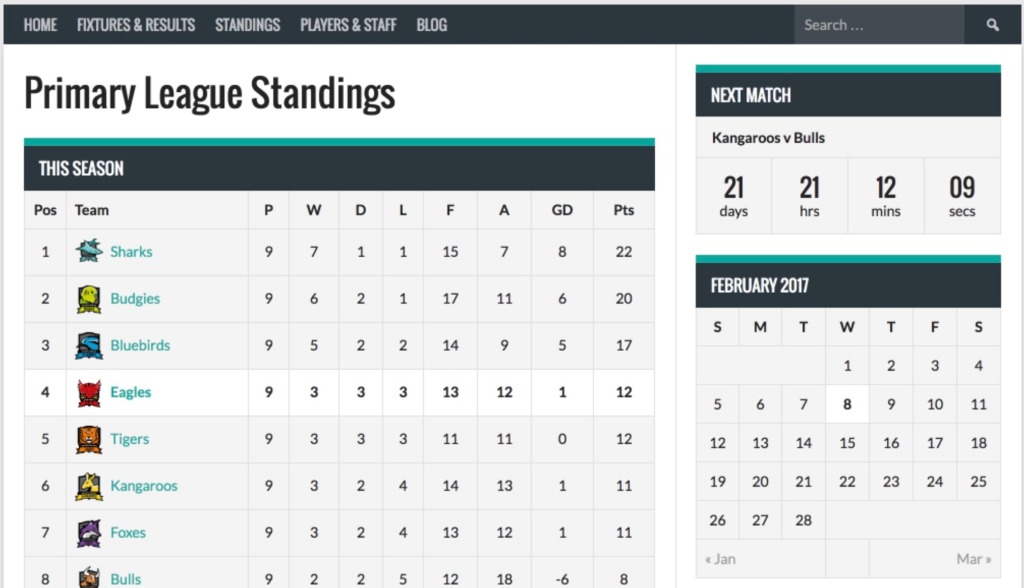
Simply visit your WordPress dashboard and select Plugins > Add New. Here are a few plugins you may consider as a sports blogger.
- YOAST SEO. Boost your blog’s visibility in search engine results through SEO. This plugin optimizes your content for specific keywords and provides a readability analysis.
- Sportspress. With this plugin, you can easily create and handle sports teams, leagues, and player profiles. Plus, it lets you display sports stats, schedules, and results right on your website.
- WP Club Manager. This plugin is specifically designed for football clubs. It lets you keep track of matches, players, and all the important club information. You can also display the fixtures, results, and league tables.
- AnWP Sports League plugin is a game changer for cricket, basketball, and volleyball bloggers, to name a few. Its user-friendly, customizable interface lets you effortlessly manage all your sports-related data while on the go.
- CoBlocks. If you want to level up content creation for your sports blog, this plugin is all you need. It provides advanced blocks for the Gutenberg editor. You can create interactive content with features like media blocks, dynamic post grids, and tables.
- Updraft Plus. Regularly backs up your blog to protect you from data loss. Please note that if you’re on a Business plan or a higher tier, you don’t need Updraft Plus, as you are already covered with Jetpack VaultPress Backup. VaultPress provides real-time backup features and effortless one-click restores out-of-the-box.
- TablePress. If you intend to frequently publish sports data or statistics tables, this handy plugin makes it easy to create and manage tables in your blog posts.
Add Pages and Navigation
Adding pages and navigation creates a structured path for your readers to follow.
Each page is a different chapter in your sports blog, offering valuable content and enhancing the user experience.
Let’s dig into the game of organizing a seamless, exciting, and informative sports blog for maximum impact.
Pages
Pages are the foundation of your sports blog. They provide direction and structure to your content.
Simply head over to your WordPress dashboard and choose Pages > Add New.
You have the option to pick a blank page and design it from the ground up, or select a pre-designed template.
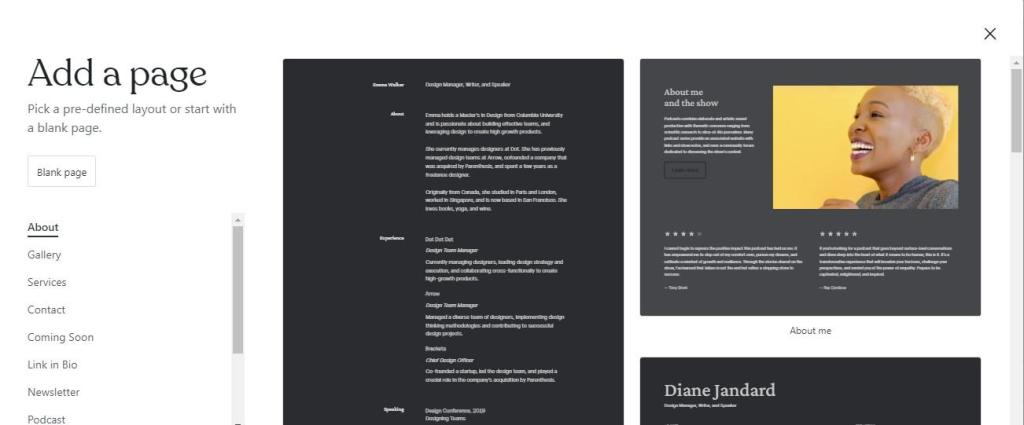
Home Page
Your website’s homepage is like a majestic stadium gate welcoming fans. It sets the tone, builds the first impression, and offers a glimpse of what your blog is about.
You can turn your casual visitors into loyal followers with a captivating layout, visually appealing graphics, and seamless navigation.
Although WordPress themes offer a default homepage, you can create one per your preferences.
Navigate to “Settings” > “Reading” from the WordPress dashboard and choose your desired homepage from the dropdown menu below “Your homepage displays.”
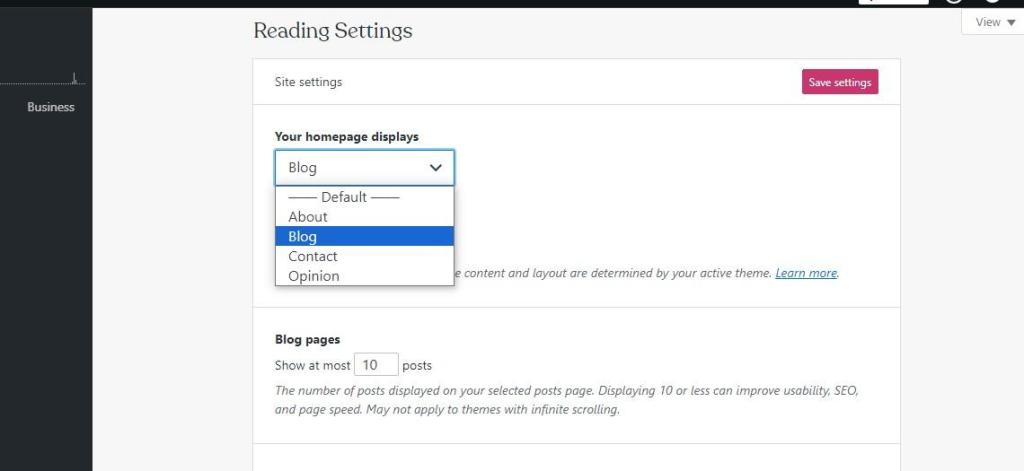
About Page
Readers who aim to connect with faces and voices behind the content generally hop over to the About Us page.
Make sure you craft an engaging About Us page to humanize your blog and tell your readers about your passion for sports.
Contact Page
Your Contact page offers a direct communication channel for your blog fans. It’s a place where sports enthusiasts and potential collaborators can reach out to you.
Since it might be an opportunity to advance your sports career, ensure creating a user-friendly and accessible page.
By doing so, you’re inviting helpful feedback, meaningful interactions, and collaboration opportunities.
Blog
This page is the center stage of your sports blog, like the stadium field where all the action takes place.
Here, readers come to catch up with the latest sports updates, commentary, and analyses. Therefore, build it cautiously to keep your readers coming back for more.
You can pick your blog’s layout by visiting “Pages” > “Add New” in the WordPress dashboard. Choose “Blog” from the menu and pick a suitable layout.
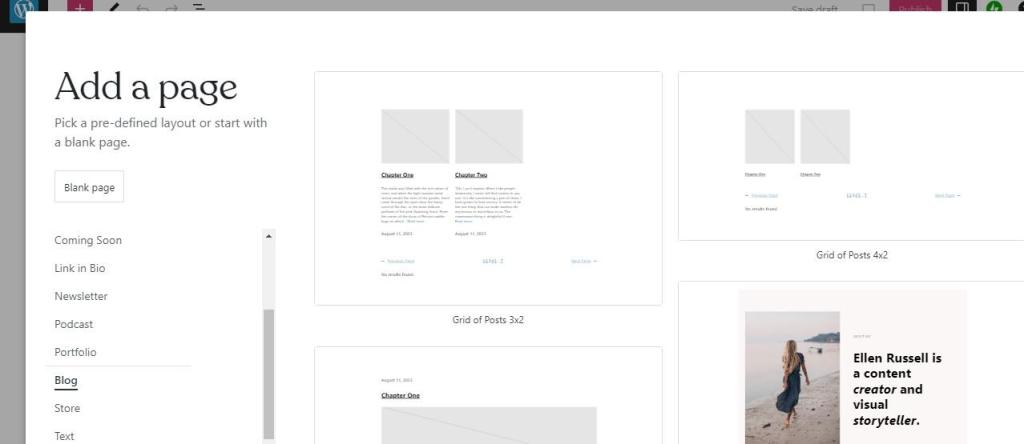
Add Categories
Sports fans are all about specifics. By using categories, you can group related content together and keep it laser-focused.
For instance, you can categorize content by sports, league, or team.
Categories make it easier for visitors to find relevant information on your website. Consequently, they’re more likely to stay on your site longer and engage with more of your content.
Add a Menu
Integrating a clear and seamless menu is vital. It ensures readers can effortlessly access the articles, discover specific pages, and explore their favorite sections.
You can customize the default menu your site comes with or build one from scratch. This quick guide covers everything about managing menus, from customization to item deletion.
Customize Header and Footer
You can customize the header and footer of your theme to give your website a consistent look, enhance user experience, and align it with your brand’s image.
If you are using a non-block theme, you can edit the header and footer by opening the customizer. Do so by selecting “Appearance -> Customize”.
Then, you can visit the “General Options” > “Header Image” to select an image for the header. You can also tailor the top and theme headers per your preferences.
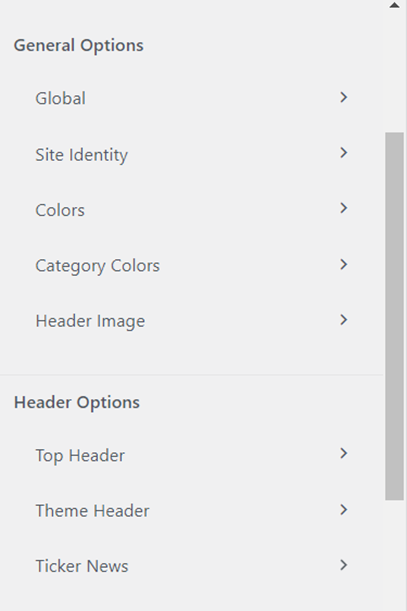
To tweak the footer, find the “Footer Options” section, which gives you options to insert the copyright text and fine-tune the fonts and colors to fit your preferences.
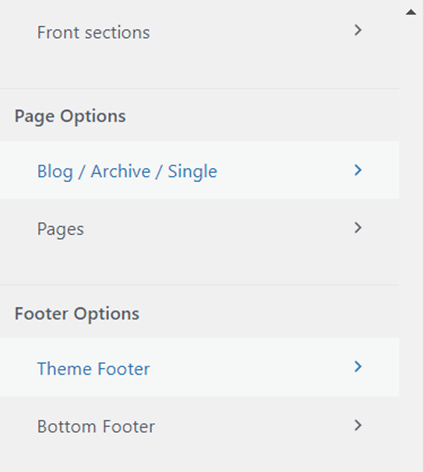
If you need any more help with customization, take a look at this guide on how to adjust your theme using the site editor (for block themes) or the customizer (for non-block themes).
Community Features
Community features allow you to build a fan base and unite sports enthusiasts visiting your blog. Features like forums, comment sections, user profiles, and social media integration allow you to encourage interactions and discussions.
You can add a Social Icons Block for visitors to quickly connect with the sports community and share your content on their profiles.
As such, your sports blog becomes more than a source of information; it transforms into a space where sports enthusiasts unite, share, and celebrate their love for sports.
Ecommerce Capabilities
Leveraging ecommerce capabilities offers you a ticket to monetization. You can set up an integrated online store that lets you sell sports-related products to intrigue visitors further and enhance their experience.
It will be like an all-in-one stadium shop, offering hats, T’s, jerseys, and even the convenience of purchasing tickets.
WooCommerce simplifies ecommerce integration by offering various customization options and features to build appealing store forefronts.
Design Considerations
A thoughtfully designed blog reinforces your brand identity and establishes trust and credibility with your audience. Here’s what to consider to engage your readers instantly and encourage them to explore your blog.
User Experience
User experience is key. Make it easy for visitors to find what they’re looking for by adding clear and organized menus.
Consider incorporating interactive elements like infographics, charts, and live scoreboards to keep the users engaged and provide a richer experience.
And since most users prefer mobile devices, your blog must be optimized for mobile phones for them to enjoy content on the go.
Aesthetics
Opt for a design that resonates with sports lovers and creates an immersive experience. For instance, go for color schemes that reflect the spirit of sports. Generally, vibrant, sports-inspired colors can evoke the excitement of the game.
Likewise, choose fonts that align with your blog’s style and boost readability and overall aesthetics.
You can also draw design inspiration from popular sports blog websites. Bleacher Report, for instance, is known for its sleek and modern look with a clear layout.

The blog uses high-quality visuals, including videos and images, to engage visitors and enhance the aesthetic appeal.
Connecting and Setting Up Analytics
Just like a sports team analyzes its game stats for every match, you should track your blog’s growth to comprehend its performance and optimize your strategy accordingly.
Below, we’ll walk you through basic yet essential tools you cannot afford to sideline if you seek to set up your blog for success.
Jetpack Stats
Jetpack stats is a built-in tool that provides valuable insights into your blog’s performance. You can access it by choosing “Stats” from your WordPress dashboard. It lets you see visitor demographics, page views, popular content, and more.
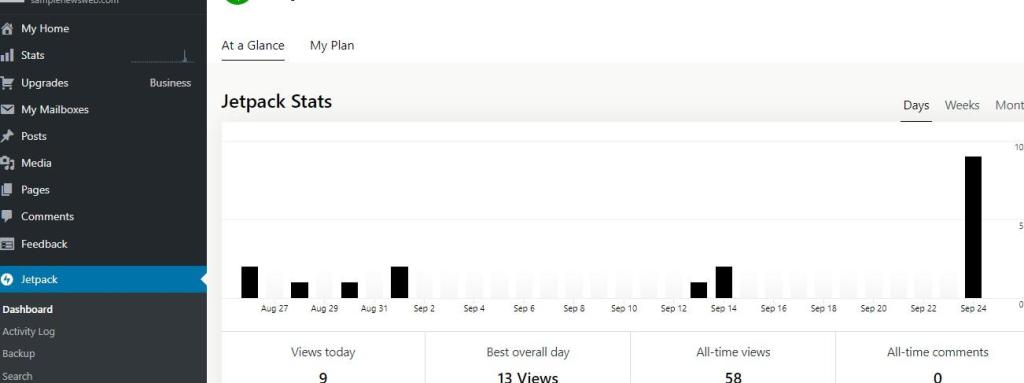
Google Analytics
Google Analytics is a comprehensive web analytics platform.
It provides an in-depth analysis of conversion rates, user behavior, traffic sources, and audience demographics.
You can leverage it through a built-in setting if you’re a Premium or Business plan user. Otherwise, you’d need to add a code or install a plugin to activate it. You can explore this guide for an in-depth overview.
Google Search Console
This tool allows you to access data about how your blog appears in search results. If you’re uncertain how to integrate it, this guide will help.
Once you verify and make it functional, you’ll be able to access unique insights into your blog’s click-through rates, search queries, impressions, performance, and issues that might affect your site’s visibility.
These tools allow you to monitor the performance of your posts and learn what your readers enjoy the most.
As a result, you can implement a data-driven approach to ensure your content is relevant, valuable, and interesting to keep the readers engaged.
Managing Writers and Contributors
Building a successful sports blog is like leading a winning team. Every great team has talented players and a strategic game plan.
In this section, we’ll address how you can add writers, define roles, recruit contributors, and create an editorial calendar to assemble your dream team and implement a well-thought-out game plan.
Add Writers and Manage Roles
Navigate to your WordPress dashboard to add writers to your blog. Go to users and click “Add New.”

Here, you can invite writers by typing their email addresses in the dedicated space. Once you do, WordPress will send them an invitation.
Now, let’s talk about roles. WordPress also offers different user roles, including
- Author. They can write and publish their own content.
- Contributor. They can draft but not publish content.
- Editor. They have complete control over all content.
Consider assigning roles based on trust and responsibilities.
Find and Recruit Contributors
Recruiting competent contributors can significantly elevate your blog’s content. As a rule of thumb, seek sports enthusiasts with a knack for writing. Consider networking with fellow bloggers.
You can also explore sports forums and social media platforms like LinkedIn and X (formerly known as Twitter) to find potential contributors.
When recruiting, ensure you focus on your blog’s audience, vision, and benefits. Highlight the chance to share their passion with a wider audience and any compensation you can offer.
Create an Editorial Calendar
Now, create an editorial calendar to keep the game on track. WordPress plugins like Editorial Calender can help in this regard. They allow you to:
- Seamlessly collaborate with your team of writers and contributors to assign articles and track progress.
- Map out topics, publication dates, and deadlines to ensure a consistent flow of high-quality posts.
- Strategically align your content with important seasons, events, and trending topics.
Promotion Strategies
You need a winning promotion strategy to ensure your blog takes the spotlight in the online world. Below, we’ll share helpful tactics to boost your blog’s visibility and keep the fans returning for more.
Social Media
Social media can be a game-changer for you when it comes to promotion, given its massive user base. Here’s how you can leverage different platforms effectively.
- X (Twitter). This can be a go-to platform for real-time updates and quick conversations. It’s like a buzzing sports bar where fans meet for instant reactions. You can share short analyses, live game updates, and spark conversations using relevant hashtags. Generally, GIFs, polls, and visually appealing graphics help boost engagement on this platform.
- Facebook. Here’s where sports fans gather for in-depth discussions. You can share live broadcasts of sports events and relevant videos. Another trick is to create fan groups for better engagement and deeper connections.
- Instagram. Instagram is a place where you can attract your target audience by sharing stunning photos and reels. You can upload HD images of memorable sports moments, athlete profiles, and behind-the-scenes glimpses.
- YouTube. Sports enthusiasts go to YouTube for detailed analyses and extended coverage. You can create your own channel to upload match highlights and player interviews. It’s a perfect platform to build a dedicated subscriber base.
If you are a WordPress.com user, you can use Jetpack Social to simplify the process of posting to social media. The feature automates posting schedules and provides valuable insights into social engagement.
Email Marketing
With over 4.26 billion users, the importance of emails for promotion cannot be overstated.
Email marketing is a direct line to your audience’s inbox. It allows you to connect with your readers and nurture relationships to keep your blog at the top of its game.
You can launch an email newsletter to keep your readers updated about the latest blog posts, sports news, and exclusive content.
However, keep these best practices in mind.
- Tailor your emails based on the reader’s interests, behavior, and location.
- Address them with their first name and use personalized subject lines to make them sound less robotic and more human. Everybody likes personalized content; your audience is no exception.
Partnerships
Forming meaningful partnerships is a winning move for your sports blog. It lets you boost credibility and further your blog’s reach.
You can collaborate with local teams to connect with their passionate fanbase. Consider reaching out to their PR departments and offering interviews or coverage.
You can also collaborate with sports influencers to broaden your reach. Reach out to them personally and define expectations for a mutually beneficial collaboration.
SEO
SEO isn’t a choice – it’s a winning strategy that propels your sports blog to the top of the podium and allows you to reach avid readers and fans.
Here are some basic SEO tips to elevate your blog’s influence and visibility.
- Keyword strategy. Research and insert relevant sports-related keywords naturally into your content to rank higher on Search Engine Result Pages (SERPs). You can use tools like Semrush, AnswerThePublic, or Google Keyword Planner to discover relevant keywords for your sports blog.
- Quality content isn’t just words on screen – it’s a meticulously crafted piece that informs, resonates, and entertains your audience.
- Internal & external links. Use internal links to guide your readers to related sports articles and boost retention on your own blog, and external links to enhance its authority by connecting with credible sources across the internet.
- Speed. Since users abandon a website that takes over 3 seconds to load, you must speed up your blog’s loading time to reduce bounce rates.
Final Analysis – Starting Your Sports Blog Journey
Launching a sports blog extends beyond personal passion; it’s an opportunity to forge a thriving community, connect with fellow sports enthusiasts, and carve a legacy in the digital sports arena.
Now that you know how to create a sports blog, it’s time to translate your strategy into real-world results.
RECAP: How to Start a Sports Blog
- Define your purpose, passion, and target audience. Naturally, you wouldn’t want your blogging journey without a clear roadmap.
- Research popular sports topics to develop an effective content strategy. Remember, content is king only when it resonates deeply with your audience’s emotions. This is your moment to define that connection.
- Pick a user-friendly platform (WordPress.com – a hassle-free site experience or WordPress.org – a resource hub that lets you download WordPress so you can install it on a host of your choice.self-hosted powerhouse that gives you complete control?)
- Set up your site. Pick a catchy domain name and an appealing theme. Remember to prioritize intuitiveness, though. Also, add relevant plugins to enhance your site’s functionality.
- Integrate social media accounts and set up analytics for insights to ensure you reach the right audience and engage effectively.
- Recruit passionate writers to ensure quality content. There’s no room for mediocre posts in the blogging world. Every piece must shine to outpace your competitors and captivate your audience.
- Promote your blog through social media and by collaborating with influencers because, without it, your well-crafted blog would be like a secret performance in an empty stadium.
Remember, with every game you cover, every post you publish, and every reader you intrigue, you’ll add your unique voice to the global sports conversation.
So, take a leap, score big, and let your sports blog journey begin today!
Want more tips? Get new post notifications emailed to you.

